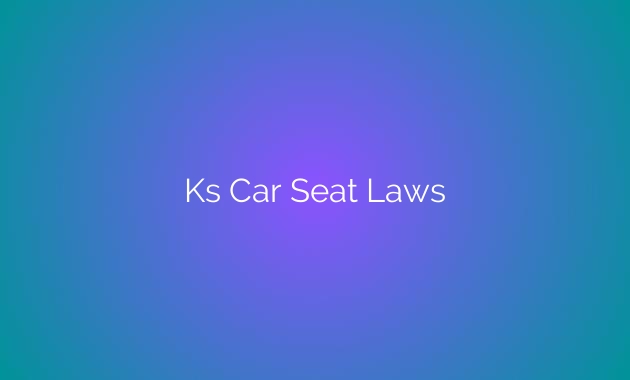Contents
- 1 Kansas Car Seat Laws: Ensuring Safety for Your Child on the Road
- 1.1 Understanding the Basics of Ks Car Seat Laws
- 1.2 Penalties for Non-Compliance with Ks Car Seat Laws
- 1.3 FAQs about Ks Car Seat Laws
- 1.3.1 1. Can I use second-hand car seats to comply with Ks car seat laws?
- 1.3.2 2. Are there any exceptions to the rear-facing requirement for infants?
- 1.3.3 3. Can I use a seat belt instead of a booster seat for my seven-year-old?
- 1.3.4 4. What if my vehicle does not have a back seat where I can install a car seat?
- 1.3.5 5. Do car seat laws apply to taxis and rideshares?
- 1.4 Conclusion
Kansas Car Seat Laws: Ensuring Safety for Your Child on the Road
When it comes to the safety of your child, there is no compromise. That is why understanding and abiding by the car seat laws in Kansas is crucial. These laws are in place to protect your little ones and reduce the risk of injuries in the event of a car accident. In this comprehensive guide, we will walk you through the ins and outs of Ks car seat laws, ensuring that you have all the information you need to keep your child safe on the road.
Understanding the Basics of Ks Car Seat Laws
In Kansas, car seat laws are designed to ensure that children are properly restrained while riding in a vehicle. The laws outline the types of car seats that should be used based on the child’s age, weight, and height. It is important to note that these laws are not mere suggestions but rather legal requirements that must be followed.
According to Ks car seat laws, infants and toddlers should be secured in rear-facing car seats until they are at least two years old or until they reach the maximum height and weight limits specified by the car seat manufacturer. This position provides optimal support and protection for their fragile neck and spine in the event of a crash.
Once a child outgrows the rear-facing car seat, they should transition to a forward-facing car seat with a harness. This type of car seat provides additional protection and is suitable for children who have reached the age, weight, and height requirements set forth by Kansas law.
As children grow older and bigger, it becomes necessary to use booster seats to ensure their safety. Kansas law requires children to use a booster seat until they are eight years old or at least 4’9 tall, whichever comes first. Booster seats help position the seat belt properly across the child’s body, reducing the risk of injury in case of an accident.
Once a child reaches the age of eight or the height requirement, they can transition to using a seat belt. However, it is crucial to ensure that the seat belt fits them properly, with the lap belt snugly across their upper thighs and the shoulder belt crossing their chest and shoulders.
Penalties for Non-Compliance with Ks Car Seat Laws
The state of Kansas takes car seat safety seriously, and failure to comply with the car seat laws can result in penalties. If you are found to be in violation of the car seat laws, you may face a fine and may be required to attend a child passenger safety class.
The fines for non-compliance with Ks car seat laws can vary depending on the municipality where the violation occurs. However, it is important to note that while the monetary penalty may vary, the risk to your child’s safety remains constant. Therefore, it is always best to ensure that you are in compliance with the law to protect your child.
FAQs about Ks Car Seat Laws
1. Can I use second-hand car seats to comply with Ks car seat laws?
It is generally recommended to avoid using second-hand car seats, as they may have been involved in an accident or may not meet the current safety standards. It is best to purchase a new car seat or borrow one from a trusted friend or family member.
2. Are there any exceptions to the rear-facing requirement for infants?
Kansas law mandates rear-facing car seats for infants until they are at least two years old. However, if a child under two exceeds the height and weight limit specified by the car seat manufacturer, they may transition to a forward-facing car seat.
3. Can I use a seat belt instead of a booster seat for my seven-year-old?

No, Kansas law requires the use of a booster seat until a child is eight years old or reaches the height requirement of 4’9. Using a seat belt before meeting these requirements may compromise the child’s safety.
4. What if my vehicle does not have a back seat where I can install a car seat?
If your vehicle does not have a back seat, such as in the case of a truck or a two-seater car, you may install a car seat in the front seat. However, you must ensure that the airbag is deactivated to prevent potential harm to the child.
Yes, Ks car seat laws apply to taxis, rideshares, and other for-hire transportation services. It is the responsibility of the driver to ensure that children are properly secured in car seats or booster seats, in compliance with the law.
Conclusion
Ensuring the safety of your child on the road is of utmost importance, and complying with Ks car seat laws is a crucial step in achieving this. By understanding the requirements and using the appropriate car seat for your child’s age, weight, and height, you can significantly reduce the risk of injuries in case of an accident. Remember, the safety of your child should always be a top priority, and abiding by the car seat laws is a non-negotiable step in protecting them.
